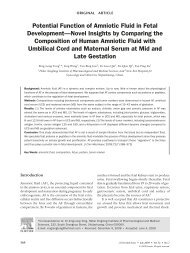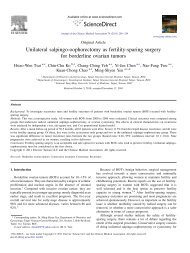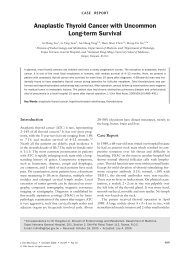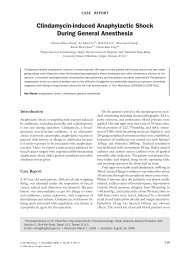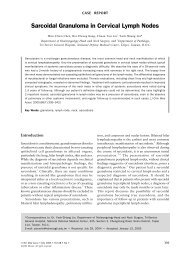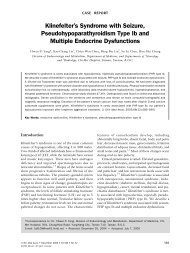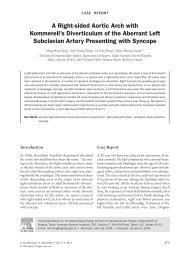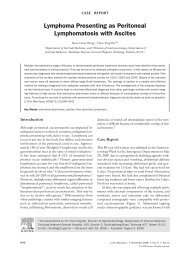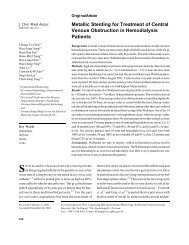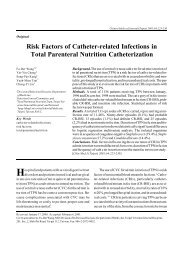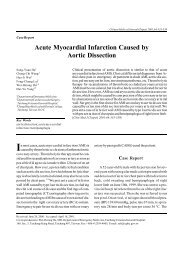Surgical Anatomy of Supratentorial Midline Lesions
Surgical Anatomy of Supratentorial Midline Lesions
Surgical Anatomy of Supratentorial Midline Lesions
You also want an ePaper? Increase the reach of your titles
YUMPU automatically turns print PDFs into web optimized ePapers that Google loves.
DISCUSSION<br />
The fibers <strong>of</strong> the corpus callosum are the major connecting pathways between the cerebral hemispheres <strong>of</strong> the human brain (4, 30). Various<br />
neurological diseases involve the corpus callosum. For instance, gliomas can arise at this site, and adjacent falcine meningiomas can cause<br />
compression. In addition, vascular malformations and aneurysms can occur in the region <strong>of</strong> the corpus callosum. An incision into the corpus<br />
callosum is generally required to reach the lateral or third ventricles. However, a callosal incision can result in various disorders: disruption <strong>of</strong><br />
interhemispheric transfer <strong>of</strong> information, interference with visuospatial transfer, difficulty in learning bimanual motor tasks, memory problems,<br />
and other deficits, including alexia, apraxia, and astereognosis (1, 6, 21, 25, 28, 33-35).<br />
Previous studies have dealt with only limited aspects <strong>of</strong> the anatomic features <strong>of</strong> the blood supply to the corpus callosum (2, 3, 5, 9-11,<br />
13-16, 18-20, 22, 23, 25-29, 32-36), and very few articles have addressed the vascularity <strong>of</strong> this region as one anatomic entity (12, 17, 24, 31). It<br />
has been the aim <strong>of</strong> the present investigation to examine the blood supply <strong>of</strong> the corpus callosum, to provide adequate information to the<br />
neurosurgeon. This accumulation <strong>of</strong> knowledge can be applied to the recognition <strong>of</strong> anatomic landmarks and variations in arterial patterns during<br />
surgery, which can ultimately guide the exploration to a successful outcome.<br />
The following summarizes our findings regarding the microsurgical anatomic features <strong>of</strong> the blood supply to the corpus callosum and<br />
indicates their surgical relevance. Three main arterial systems supply the corpus callosum: the ACoA, the pericallosal artery, and the posterior<br />
pericallosal artery.<br />
Contribution <strong>of</strong> the ACoA<br />
The ACoA branches are divided into three subgroups: the hypothalamic artery, the subcallosal artery, and the median callosal artery. The<br />
hypothalamic artery arose from the ACoA in 85% <strong>of</strong> our specimens; in the other 15%, it arose from the subcallosal artery or the median callosal<br />
artery. In no specimen did the hypothalamic artery contribute to the blood supply <strong>of</strong> the corpus callosum.<br />
The subcallosal artery is rarely mentioned in the literature, because <strong>of</strong> the use <strong>of</strong> a different classification for the various branches arising<br />
from the ACoA complex (19, 34). Marinkovic et al.(19) found a subcallosal artery present in 91% <strong>of</strong> his specimens, whereas it occurred in 50%<br />
<strong>of</strong> our specimens, always as a single dominant artery.<br />
Previous studies have discussed the contribution <strong>of</strong> the median callosal artery to the blood supply <strong>of</strong> the corpus callosum, and the artery<br />
was reported to be present in less than 20% <strong>of</strong> specimens (2, 11, 14, 16, 19, 23, 27, 29, 31, 34). In our observations, the median callosal artery<br />
was present in 30% <strong>of</strong> the specimens. We identified two vascular patterns, which are based on their distal arterial distributions, and we called<br />
these “classical" and “hemispheric." The presence <strong>of</strong> the median callosal artery and the existence <strong>of</strong> anastomoses with the various<br />
branches <strong>of</strong> the PCA, middle cerebral artery, or ACA systems can provide an adequate source <strong>of</strong> collateral flow when temporary vessel<br />
occlusion is needed during surgery.<br />
In an earlier publication (34) by the senior author(M.G.Y.), the branches <strong>of</strong> the ACoA complex were classified using different terminology.<br />
The previous terminology has been modified in this study as follows: the small third A2 is now identified as the subcallosal artery, the moderate<br />
third A2 as the classical type <strong>of</strong> median callosal artery, and the large third A2 as the hemispheric type <strong>of</strong> median callosal artery.<br />
Marinkovic et al. (19) classified the branches <strong>of</strong> the ACoA according to the diameter at their origin as either small (hypothalamic) or large<br />
(subcallosal and median callosal). We have advocated classifying these arteries according to their territories <strong>of</strong> supply, because occasionally, in<br />
different specimens, the diameter <strong>of</strong> the hypothalamic artery or the subcallosal artery was found to be equal to, or larger than, that <strong>of</strong> the median<br />
callosal artery. Thus, when we explore the ACoA complex during surgery, we cannot conclusively identify its branches simply by comparing the<br />
diameters at their origins.<br />
In our study <strong>of</strong> 20 brain specimens, we did not observe the azygos variation <strong>of</strong> the ACA. However, in the literature, the incidence is<br />
reported to range from 1 to 5% (2, 11, 13, 15, 34).<br />
Before surgically approaching the ACoA complex in the case <strong>of</strong> an aneurysm, arteriovenous malformation, or tumor, the possible arterial<br />
variations that may occur in this area must be carefully considered. In particular, a careful study <strong>of</strong> the angiogram is strongly indicated because<br />
<strong>of</strong> the very high probability <strong>of</strong> the presence <strong>of</strong> a subcallosal artery or a median callosal artery, and because preserving these important vessels<br />
during surgery is crucial to a successful outcome.<br />
Contribution <strong>of</strong> the pericallosal artery



